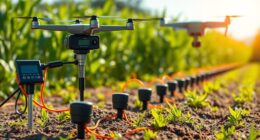To protect livestock from coyotes and dogs, use a combination of physical barriers like predator-proof fencing and electric fences. Incorporate guard animals such as dogs, llamas, or donkeys to scare off predators naturally. Remove attractants like unsecured feed or carcasses and clear brushy areas that offer hiding spots. Community effort and habitat management are key. By applying these strategies, you can reduce risks considerably—keep exploring to discover more effective ways to defend your livestock.
Key Takeaways
- Implement predator-proof fencing and electric barriers to physically prevent coyote and dog intrusions.
- Use guard animals like dogs, llamas, or donkeys to actively deter predators from livestock areas.
- Remove attractants such as carcasses, waste, and unsecured feed to reduce predator lure and activity.
- Modify habitat by clearing brush and tall grass to minimize hiding spots and stalking opportunities.
- Employ community education and integrated strategies combining deterrents, habitat management, and monitoring for effective protection.

Have you ever wondered how wildlife managers control predator populations to protect livestock, endangered species, or human interests? It’s a complex task that involves understanding coyote behavior and implementing strategies to guarantee livestock security. Coyotes are highly adaptable predators, known for their intelligence and resourcefulness. They often hunt at dawn, dusk, or during the night, taking advantage of low visibility to approach prey. Recognizing these patterns helps managers develop effective measures to reduce conflicts. Coyotes tend to be opportunistic feeders, so managing their behavior involves limiting easy food sources and making livestock less attractive targets.
Understanding coyote habits helps protect livestock and reduce conflicts effectively.
To improve livestock security, managers often employ a combination of physical barriers, such as fencing, and behavioral deterrents. Fencing, especially predator-proof designs, can substantially decrease coyote incursions. Electric fencing, for example, creates an unpredictable deterrent that makes it difficult for coyotes to breach. Additionally, guard animals like dogs, llamas, or donkeys are used to protect herds by actively scaring off or confronting predators. These animals leverage their natural instincts to defend livestock, and their presence can alter coyote behavior, making predators less likely to approach.
Beyond physical deterrents, managers also focus on reducing attractants that draw coyotes in the first place. Properly disposing of carcasses and waste, along with securing feed storage, prevents coyotes from scavenging close to livestock areas. In some cases, habitat modification is necessary—removing brush piles, tall grass, or other cover that provides hiding spots for coyotes can discourage their presence near farms. This approach directly influences coyote behavior by making the environment less inviting for stalking and ambush, thereby increasing livestock security. Incorporating an understanding of coyote behavior patterns can enhance the effectiveness of management strategies.
Humane lethal control methods, such as targeted trapping and shooting, are sometimes employed when non-lethal strategies aren’t enough. These measures are used carefully and selectively, often as a last resort, to manage local coyote populations without disrupting the broader ecosystem. Education also plays a crucial role; informing landowners about coyote behavior and effective management techniques helps foster community cooperation. When everyone understands how coyotes operate and the importance of proactive measures, it enhances overall livestock security.
Ultimately, successful predation management hinges on a deep understanding of coyote behavior and a thorough approach that combines physical deterrents, habitat management, and community engagement. By staying vigilant and adaptable, you can considerably reduce threats to your livestock, protect endangered species, and maintain a balanced coexistence with local wildlife.
Frequently Asked Questions
What Are the Legal Considerations in Coyote and Dog Management?
You need to guarantee legal compliance when managing coyotes and dogs, as it helps you avoid liability concerns. Check local, state, and federal laws because some methods, like traps or poisons, may be restricted or require permits. Always follow regulations to prevent legal issues and protect yourself from liability. Staying informed and compliant ensures your management efforts are effective and legally sound.
How Do Predator Behaviors Vary Across Different Regions?
You might think predator behaviors are uniform, but regional coyote behavioral differences prove otherwise. Studies suggest that coyotes adapt their hunting and social strategies based on local prey availability and human activity. In some regions, coyotes are more nocturnal and cautious, while in others, they’re bolder and more aggressive. These variations influence how you should approach predator management, tailoring strategies to specific regional coyote behaviors for effective livestock protection.
Are There Non-Lethal Methods Effective for Long-Term Control?
Yes, non-lethal deterrents can be effective for long-term control if you combine them with habitat modification. Using non-lethal deterrents like sound devices, motion-activated lights, or fencing can keep coyotes and dogs away. Habitat modification, such as removing brush or securing trash, reduces attractants. Consistently applying these methods creates an environment less appealing to predators, making long-term protection of your livestock more achievable.
How Can Community Cooperation Improve Predation Management?
Community engagement and collaborative strategies markedly improve predation management by fostering shared responsibility and pooled resources. When you work with neighbors, local agencies, and wildlife experts, you can develop tailored solutions that address specific risks. This teamwork enhances communication, guarantees consistent application of non-lethal methods, and builds trust. Together, you create a united front that effectively protects livestock while maintaining healthy ecosystems through proactive, community-driven efforts.
What Are the Economic Impacts of Predation on Livestock?
You should know that predation causes significant economic losses for livestock owners, affecting their income and sustainability. These losses often lead to increased costs for livestock compensation and preventive measures. When predator attacks rise, you might face higher insurance premiums or reduced profits. Managing these impacts requires proactive strategies to minimize economic damage, ensuring your livestock remains protected and your livelihood stays secure amidst predator threats.
Conclusion
By implementing effective predation management strategies, you can protect your livestock from coyotes and dogs. Stay proactive and adaptable, because an ounce of prevention is worth a pound of cure. Remember, you’re only as strong as your weakest link, so don’t overlook small details that could make a big difference. With consistent effort and awareness, you can keep your animals safe and secure, ensuring your peace of mind and the health of your farm.










